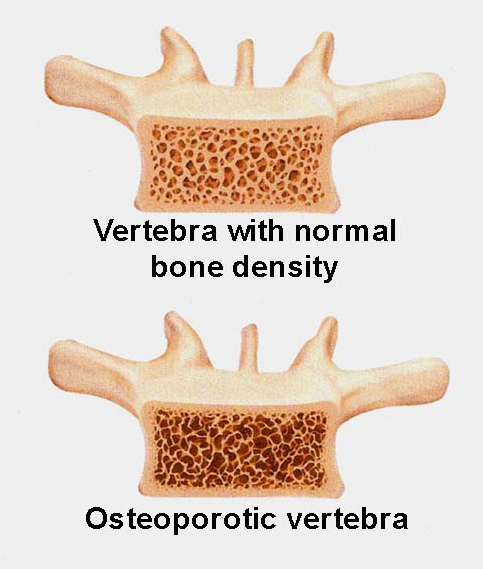Osteoporosis (common cause of increased fracture risk)
This condition refers to a thinning of the bones. The bones of our skeleton are in constant turnover, with some cells (osteoblasts) making new bone as other cells (osteoclasts) resorb new bone. Usually the addition and resorption (loss) of new bone is in balance, but in certain situations, this balance can be upset with a net effect of loss of bone.
Like with a chicken bone, there is a hard outside part of the bone (cortex, or cortical bone), and a spongy inside part (cancellous bone). In the illustration below, the difference between normal and osteoporotic spongy bone can be seen.

In this illustration of a spinal vertebra, the thinner spongy inside part of the bone leads to bony weakness, with increased risk of fracture.
Risk factors for osteoporosis include:
--Advanced age
--Female
--Thin body habitus, small frame
--Caucasian or Asian (although Black and Hispanic patients at risk as well)
Smoker
--Estrogen deficiency, from menopause or surgically induced (ovaries removed)
--Absence of menstrual periods
--Vitamin D deficiency
--Family history of osteoporosis
--Certain medications (steroids, chemotherapy, anticonvulsants)
--Low testosterone levels in men
--Excessive alcohol use
--Inactive lifestyle

Risk Prevention for Osteoporosis
--Assure adequate intake of Calcium, at least a 1000 mg a day, and Vitamin D, at least 800 IU but may be as high as 2000 IU, or International Units per day
--Weightbearing exercise
--Exposure to sunlight (unless prone to skin cancers or housebound)
--Add soy to the diet (contains plant estrogens)
--Don’t smoke
--Consider hormone therapy (check with your doctor)
--Avoid excessive alcohol
--Limit caffeine
Treatment Strategies for Osteoporosis
Medications, as noted below, are usually prescribed by your internist, as each considered treatment option has factors for and against its use.
Bisphosphonates: these drugs inhibit bone breakdown, help to preserve bone mass, and sometimes increase bone density. These medications are often useful for patients with steroid induced osteoporosis, like with chronic asthma. Examples include:
Fosamax (Alendronate),
Boniva (Ibandronate),
Actonel (Risedronate).
Raloxifene (Evista): mimics beneficial effects of estrogen on bones without some of the risks associated with estrogen, like breast and uterine cancer. Should avoid if there is history of blood clots.
Calcitonin: a hormone produced by the thyroid gland, is usually administered as nasal spray, helps prevent bone loss. Less effective than the bisphosphonates.
Teriparatide (Forteo): currently under study, is similar to parathyroid hormone, which is can strongly influence bone metabolism by stimulating new bone growth. Long term effects as yet unknown.
